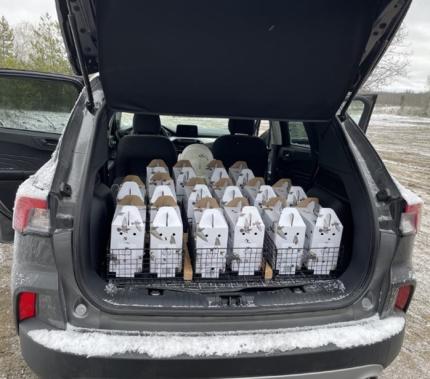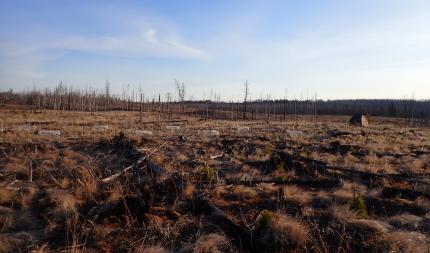Managing Wildlife Populations
Greater Sage-grouse: Biologists across Douglas County are finishing up monitoring known greater sage-grouse lek sites. Sage-grouse numbers recorded so far this spring represent an increase over the previous several years. This is very encouraging to see because this species is classified as Endangered in Washington and has been experiencing a dramatic population decline for many years now. For more information on greater sage-grouse in Washington, visit the Washington Department of Fish and Wildlife website.
Columbian Sharp-tailed Grouse Translocation: Biologists Eilers joined other biologists to trap and relocate 60 sharp-tailed grouse from British Columbia, Canada into Washington. This will help supplement the species abundance and genetic diversity in Washington. Sharp-tailed grouse are State Endangered and are a Species of Greatest Conservation Need due to their low and declining numbers in Washington.
The translocation effort involved finding leks (breeding display grounds where males dance to attract females) in British Columbia, setting up walk-in traps, and then returning each morning to watch from a blind as the birds performed their daily displays. Once a bird found itself in a trap, biologists quickly left the blind and captured the bird to bring it to a processing site. All 60 grouse (30 males and 30 females) were banded, and half of them were outfitted with a radio collar to allow biologists to track their movements. Half of the birds were released in northern Douglas County and the other half were released in Lincoln County. For more information about this species visit the Washington Department of Fish and Wildlife website.




Sharp-tailed Grouse Management: Biologist Heinlen traveled to 70 Mile House, British Columbia and participated in trapping Columbia sharp-tailed grouse for augmentation back into Washington. After much planning, logistical coordination, and field work by many staff members, everything aligned perfectly, and 60 (30 males and 30 females) sharp-tailed grouse were captured and successfully released in Washington in six trapping days. The goal is to bolster the Washington population by increasing genetic diversity.
Biologist Heinlen also conducted annual surveys for Columbia sharp-tailed grouse within District 6. Relocating leks (breeding grounds) that have moved, and a mild winter has led to a better survey effort and an increase in sharp-tailed grouse numbers over the 2023 surveys.
Biologist Heinlen and Confederated Tribes of the Colville Reservation Wildlife Biologist Laspa toured a property in Tunk Valley that the tribe acquired a couple years ago. Before the tribe acquired the property, Biologist Heinlen conducted the sharp-tailed grouse surveys on it. During the tour Biologists Heinlen and Laspa were fortunate enough to relocate a lek that hasn’t been active in over 20 years.



Sage Grouse Surveys: Biologist Morris completed grid searches for sage grouse in Grant and Douglas counties. Morris saw some great sunrises, picturesque landscapes, and lots of upland birds while surveying.
Bighorn Sheep Management: Biologist Heinlen investigated a bighorn sheep mortality in the Mt. Hull herd. Not enough was left to determine a definitive cause of death. However, disease and parasite samples were taken and sent to Washington Animal Disease Diagnostic Laboratory at Washington State University for analysis. The radio collar was also retrieved.

Mule Deer Management: Biologist Heinlen and Washington Department of Fish and Wildlife Volunteer Fischer investigated a mule deer mortality. They found it to be predated by a cougar. The radio collar was recovered.
Convention on International Trade in Endangered Species (CITES) Sealing: Biologist Heinlen sealed several bobcat pelts from Okanogan County with CITES tags this period. CITES is an international agreement that aims to ensure that international trade in specimens of wild animals and plants does not threaten their survival. Because the trade in wild animals and plants crosses borders between countries, the effort to regulate it requires international cooperation to safeguard certain species from over-exploitation. The deadline for sealing has now passed. All bobcat and river otter pelts harvested this season were required to be sealed by April 20.
Lek Searches: Biologist Turnock and Technician Hara continued searching for new sage and sharp-tailed grouse leks in northern Douglas County. High winds have made surveying difficult, but they were able to cover four grids. This will help inform our understanding of these species’ distributions in Region 2.
Sharp-tailed Grouse Translocations: Technician Force assisted staff members in translocating 60 sharp-tailed grouse from British Columbia to Dyer Hill and Swanson Lakes Wildlife Areas.

Northern Leopard Frog Surveys: Biologist Turnock and Technician Hara conducted northern leopard frog breeding surveys in District 5, including at Potholes off road vehicle (ORV) park. They did not detect any leopard frogs, but these surveys resulted in some exciting incidental observations such as a badger with three young and breeding Great Basin spadefoot toads.

Pygmy Rabbit Trapping: Biologist Turnock and Technician Hara assisted Biologist Crowell with pygmy rabbit trapping at the B3 enclosure near Beezley Hills. They were able to capture the enclosure’s lone resident, an adult male rabbit, to confirm his survival.

Providing Recreation Opportunities
Hunter Access: Biologist Morris checked and posted signs on hunter access properties.
Providing Conflict Prevention and Education
Deer Issues: Specialist Heilhecker spoke with a landowner regarding acclimated deer in his yard. A group of seventeen deer have been eating flower gardens and walking across the porch. Specialist Heilhecker provided recommendations on how to nonlethally haze the deer.
Cost-Share Fencing: Specialist Heilhecker ordered fencing materials for an orchard experiencing deer damage. The orchardist signed a cost-share fencing agreement. Subsequently, Washington Department of Fish and Wildlife orders materials and arranges for the materials to be delivered onsite. Then, the orchardist installs the fence.
Range Rider Information Sharing: Specialist Heilhecker answered questions from an individual interested in becoming a contracted range rider. She met with wildlife conflict section staff members to discuss the individual’s application and funding availability.
Conserving Natural Landscapes
Habitat Plots: Biologists Cook and Morris pulled cheatgrass weeds from around 200 recently planted shrubs, from this spring and last year. Plastic mulch was used but the weeds were aggressively growing through the holes cut for the planted shrubs. Machine cutting the grass was unfeasible due to the small size of some shrubs and the thickness of weeds. Pre-emergent herbicide will be used to prevent regrowth of weeds.
Habitat Plots: Biologist Morris sprayed weeds at one of the habitat plots he has been working on. By controlling weeds, it allows the native plants to get established with less competition for available soil moisture and nutrients. Around 200 of the native trees and shrubs were planted in plastic mulch to prevent weed competition, but cheatgrass was growing through the holes where the shrubs were planted. Biologist Morris and Biologist Cook spent some time removing the cheatgrass manually from these holes.

Providing Education and Outreach
Science, Technology, Engineering and Math (STEM) Day in the Field: Biologist Cook participated in the Science, Technology, Engineering and Math (STEM) day in the field at the Desert Unit of Columbia Basin Wildlife Area. Cook participated in providing instruction for groups of 6th graders around wildlife resources and their effect and interaction with the environment.

Turkey Hunting Information: Specialist Heilhecker provided feedback to a hunter who called looking for places to hunt turkeys.
Conducting Business Operations and Policy
Wolf Advisory Group Meeting: Specialist Heilhecker participated in the Wolf Advisory Group (WAG) meeting and participated in the WAG coordination meetings.
Firearm Certification: Specialists Heilhecker and Bridges, and Supervisor Rickel all completed annual firearms qualifications.
Other
CPR Training: Specialist Heilhecker, Supervisor Rickel and Private Lands Biologists Braaten, Morris and Cook attended CPR training in Ephrata.